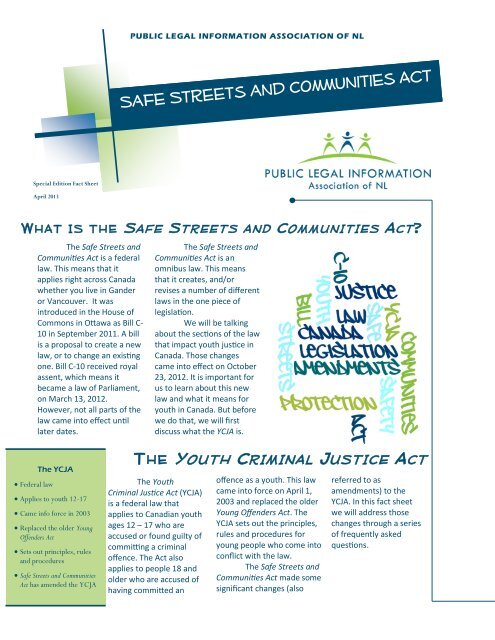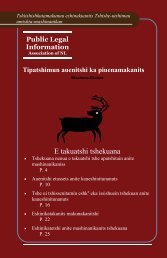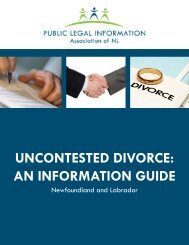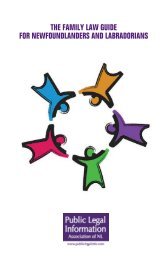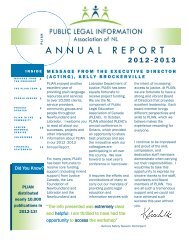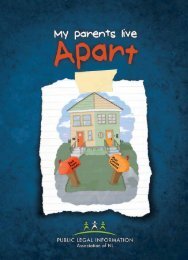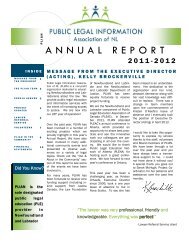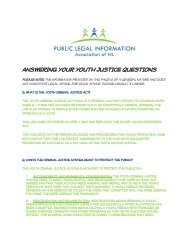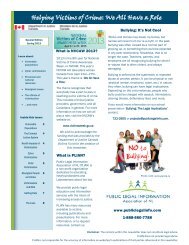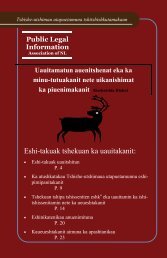the youth criminal justice act - Public Legal Information » Association ...
the youth criminal justice act - Public Legal Information » Association ...
the youth criminal justice act - Public Legal Information » Association ...
You also want an ePaper? Increase the reach of your titles
YUMPU automatically turns print PDFs into web optimized ePapers that Google loves.
PUBLIC LEGAL INFORMATION ASSOCIATION OF NL<br />
Special Edition F<strong>act</strong> Sheet<br />
April 2013<br />
WHAT IS THE SAFE STREETS AND COMMUNITIES ACT?<br />
The Safe Streets and<br />
Communities Act is a federal<br />
law. This means that it<br />
applies right across Canada<br />
whe<strong>the</strong>r you live in Gander<br />
or Vancouver. It was<br />
introduced in <strong>the</strong> House of<br />
Commons in Ottawa as Bill C-<br />
10 in September 2011. A bill<br />
is a proposal to create a new<br />
law, or to change an existing<br />
one. Bill C-10 received royal<br />
assent, which means it<br />
became a law of Parliament,<br />
on March 13, 2012.<br />
However, not all parts of <strong>the</strong><br />
law came into effect until<br />
later dates.<br />
The Safe Streets and<br />
Communities Act is an<br />
omnibus law. This means<br />
that it creates, and/or<br />
revises a number of different<br />
laws in <strong>the</strong> one piece of<br />
legislation.<br />
We will be talking<br />
about <strong>the</strong> sections of <strong>the</strong> law<br />
that imp<strong>act</strong> <strong>youth</strong> <strong>justice</strong> in<br />
Canada. Those changes<br />
came into effect on October<br />
23, 2012. It is important for<br />
us to learn about this new<br />
law and what it means for<br />
<strong>youth</strong> in Canada. But before<br />
we do that, we will first<br />
discuss what <strong>the</strong> YCJA is.<br />
Federal law<br />
The YCJA<br />
Applies to <strong>youth</strong> 12-17<br />
Came info force in 2003<br />
Replaced <strong>the</strong> older Young<br />
Offenders Act<br />
Sets out principles, rules<br />
and procedures<br />
Safe Streets and Communities<br />
Act has amended <strong>the</strong> YCJA<br />
THE YOUTH CRIMINAL JUSTICE ACT<br />
The Youth<br />
Criminal Justice Act (YCJA)<br />
is a federal law that<br />
applies to Canadian <strong>youth</strong><br />
ages 12 – 17 who are<br />
accused or found guilty of<br />
committing a <strong>criminal</strong><br />
offence. The Act also<br />
applies to people 18 and<br />
older who are accused of<br />
having committed an<br />
offence as a <strong>youth</strong>. This law<br />
came into force on April 1,<br />
2003 and replaced <strong>the</strong> older<br />
Young Offenders Act. The<br />
YCJA sets out <strong>the</strong> principles,<br />
rules and procedures for<br />
young people who come into<br />
conflict with <strong>the</strong> law.<br />
The Safe Streets and<br />
Communities Act made some<br />
significant changes (also<br />
referred to as<br />
amendments) to <strong>the</strong><br />
YCJA. In this f<strong>act</strong> sheet<br />
we will address those<br />
changes through a series<br />
of frequently asked<br />
questions.
P A G E 2<br />
S A F E S T R E E T S AND C O M M U N I T I E S A CT<br />
FREQUENTLY ASKED QUESTIONS<br />
Q : What is <strong>the</strong> purpose of <strong>the</strong> YCJA amendments made<br />
under <strong>the</strong> Safe Streets and Communities Act?<br />
A: The amendments to <strong>the</strong> YCJA, which came into effect on<br />
October 23, 2012, focus on protecting society. The amendments<br />
also provide options to help ensure that violent and repeat <strong>youth</strong><br />
offenders are held fully accountable under <strong>the</strong> YCJA.<br />
Q: How does <strong>the</strong> Safe Streets and Communities Act (SSCA)<br />
change <strong>the</strong> Youth Criminal Justice Act?<br />
A: There are 9 major changes <strong>the</strong> YCJA as a result of <strong>the</strong> new Safe<br />
Streets and Communities Act. They are:<br />
1) Protection of <strong>the</strong> public is now highlighted as a key goal of <strong>the</strong> <strong>youth</strong> <strong>justice</strong> system.<br />
2) Rules have been changed to make it easier to keep violent and repeat accused <strong>youth</strong>s in<br />
custody before trial.<br />
3) Judges can now hand down punishments that are meant to discourage (or deter) <strong>the</strong> young<br />
person being sentenced from committing future crimes.<br />
4) The meaning of “violent offence” under <strong>the</strong> YCJA has been expanded.<br />
5) Judges can now consider past <strong>criminal</strong> behavior of a young person, including where police<br />
have used certain out-of-court options to deal with him/her, when determining whe<strong>the</strong>r <strong>the</strong><br />
young person is eligible for custody.<br />
6) The Crown (government lawyer) has to think about asking for an adult punishment if a <strong>youth</strong><br />
is charged with certain crimes (such as murder, attempted murder, manslaughter, and<br />
aggravated sexual assault). If <strong>the</strong> lawyer decides not to ask for an adult punishment, he/she<br />
has to let <strong>the</strong> Court know.<br />
7) <strong>Information</strong> about a young person’s identity can be made public if he/she has been given a<br />
<strong>youth</strong> sentence for a violent offence, and <strong>the</strong> court has public safety concerns.<br />
8) Police are now required to keep records when <strong>the</strong>y decide to take no fur<strong>the</strong>r <strong>act</strong>ion, warn,<br />
caution, or refer a young person in response to an alleged offence.<br />
9) Youth under 18 years of age have to serve custody in <strong>youth</strong> facilities regardless of whe<strong>the</strong>r<br />
<strong>the</strong>y are given a <strong>youth</strong> or adult punishment.
S P E C I A L E D I T I O N F A C T S H E E T<br />
P A G E 3<br />
TEST YOUR KNOWLEDGE!<br />
Take our quiz to see how much learned from this f<strong>act</strong> sheet! Get your score by<br />
checking <strong>the</strong> answers on <strong>the</strong> bottom of <strong>the</strong> last page.<br />
1. Does <strong>the</strong> Safe Streets and Communities Act apply only in Newfoundland and Labrador or<br />
across Canada?<br />
2. The Safe Street and Communities Act was originally a bill. What is a bill?<br />
3. What was <strong>the</strong> bill number for <strong>the</strong> Safe Street and Communities Act?<br />
4. When did <strong>the</strong> bill receive royal assent?<br />
5. The Safe Streets and Communities Act is an “omnibus Act”. What does that mean?<br />
6. What does YCJA stand for?<br />
7. How old must a person be before <strong>the</strong>y can be charged in Canada for a <strong>criminal</strong> offence?<br />
8. When did <strong>the</strong> YCJA come into effect in Canada?<br />
9. What law did <strong>the</strong> YCJA replace?<br />
10. Name at least two examples of how <strong>the</strong> Safe Streets and Communities Act changed <strong>the</strong><br />
YCJA.
PUBLIC LEGAL INFORMATION ASSOCIATION OF NL<br />
WHERE TO GET A COPY<br />
The Safe Streets and Communities Act<br />
is available on <strong>the</strong> Government of<br />
Canada website at:<br />
http://laws-lois.<strong>justice</strong>.gc.ca/eng/<br />
AnnualStatutes/2012_1/<br />
LOOKING FOR MORE INFORMATION?<br />
Below you can get more information about <strong>the</strong> changes that <strong>the</strong> Safe Streets and<br />
Communities Act has made to <strong>the</strong> Youth Criminal Justice Act:<br />
http://www.<strong>justice</strong>.gc.ca/eng/news-nouv/nr-cp/2012/doc_32802.html<br />
http://www.<strong>justice</strong>.gc.ca/eng/news-nouv/nr-cp/2011/doc_32633.html<br />
http://www.<strong>justice</strong>.gc.ca/eng/news-nouv/nr-cp/2012/doc_32713.html<br />
CONTACT US<br />
<strong>Public</strong> <strong>Legal</strong> <strong>Information</strong> <strong>Association</strong> of NL<br />
(PLIAN) is a non-profit organization dedicated to<br />
educating Newfoundlanders and Labradorians<br />
about <strong>the</strong> law. We provide public legal education<br />
and information services with <strong>the</strong> intent of<br />
increasing access to <strong>justice</strong>.<br />
Suite 227, 31 Peet Street, Tara Place<br />
St. John’s, NL A1B 3W8<br />
Phone: 709-722-2643<br />
Toll Free: 888-660-7788<br />
Fax: 709-722-0054<br />
Email: info@publiclegalinfo.com<br />
The information provided in this publication is<br />
not intended as legal advice, but ra<strong>the</strong>r to<br />
provide general information.<br />
Answers: 1. Across Canada; 2. A bill is a proposal to create a new law, or to change an existing one; 3. Bill C-10; 4. March 13,<br />
2012; 5. it created, and/or revised a number of laws in <strong>the</strong> one piece of legislation; 6. Youth Criminal Justice Act; 7. 12 years of<br />
age; 8. April 1, 2003; 9. Young Offenders Act; 10. See <strong>the</strong> listed 9 changes on page 2 of this f<strong>act</strong> sheet.


